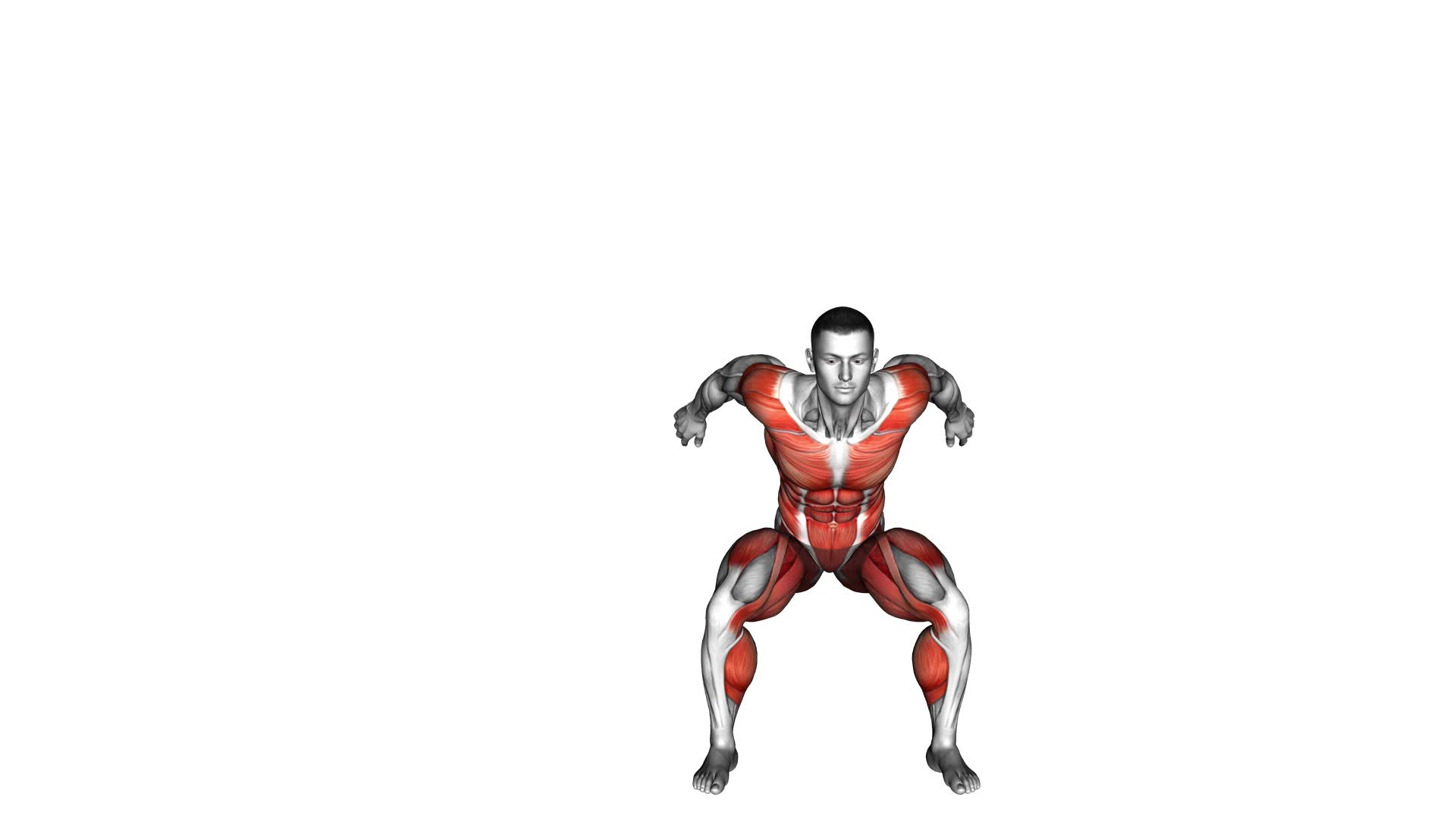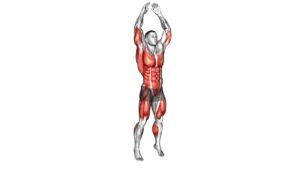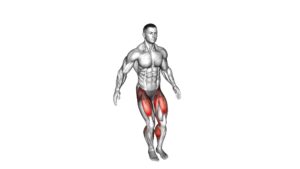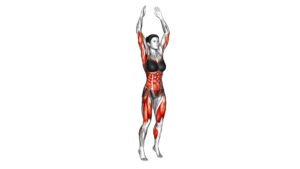Side Hop Ski (male) – Video Exercise Guide & Tips

Are you looking for a dynamic exercise that targets your lower body and improves your agility? Look no further than the Side Hop Ski!
Watch This Exercise Video
In this video exercise guide, we'll show you the proper form and technique to maximize your results.
Discover the benefits of this exercise, common mistakes to avoid, and variations to challenge yourself.
Get ready for a successful workout with these helpful tips.
Let's get hopping!
Key Takeaways
- Side Hop Ski improves agility, coordination, and reaction time.
- Side Hop Ski strengthens quadriceps, hamstrings, calves, and glutes.
- Proper form and technique, such as landing softly and keeping knees bent, are important in Side Hop Ski.
- Increasing the height of the object jumped over and incorporating interval training or plyometrics can progress Side Hop Ski workouts.
Proper Form and Technique
To perform the Side Hop Ski exercise with proper form and technique, start by standing with your feet shoulder-width apart. This exercise is excellent for improving balance and increasing agility. Begin by bending your knees slightly and keeping your chest lifted and core engaged.
From this starting position, imagine you're skiing down a slope. Jump laterally to the right, landing softly on your right foot while keeping your left foot off the ground. As you land, maintain a slight bend in your knees to absorb the impact. Immediately push off with your right foot and jump laterally to the left, landing softly on your left foot.
Remember to keep your chest lifted and core engaged throughout the movement. Continue to alternate sides, jumping laterally with control and precision. As you progress, try to increase the speed and intensity of the jumps, while maintaining proper form and technique.
This exercise is an effective way to challenge your balance and agility, helping you to develop coordination and stability in your lower body.
Benefits of Side Hop Ski
Improve your balance and agility with the Side Hop Ski exercise. This exercise offers several benefits that can help you reach your fitness goals.
One of the main advantages of the Side Hop Ski is its ability to improve agility. By incorporating lateral jumps and quick changes of direction, this exercise challenges your body to move in different planes of motion. This helps to enhance your coordination, reaction time, and overall agility.
Additionally, the Side Hop Ski is a great exercise for burning calories. The explosive movements and continuous hopping engage multiple muscle groups and elevate your heart rate, resulting in an increased calorie burn. This makes it an effective exercise for those looking to lose weight or maintain a healthy body composition.
Moreover, the Side Hop Ski also strengthens your lower body muscles, including your quadriceps, hamstrings, calves, and glutes. By repeatedly jumping from side to side, you're building strength and power in these muscle groups, which can improve your athletic performance in activities that require explosive movements.
Incorporating the Side Hop Ski into your workout routine can offer numerous benefits, such as improved agility, increased calorie burn, and strengthened lower body muscles. So, why not give it a try and start reaping these rewards today?
Common Mistakes to Avoid
To ensure proper form and maximize the benefits of the Side Hop Ski exercise, it's important to avoid some common mistakes. By avoiding these mistakes, you can minimize the risk of injuries and maximize the results of your workout.
One common mistake to avoid is using improper technique. When performing the Side Hop Ski, it's crucial to maintain proper form throughout the exercise. This includes keeping your knees slightly bent, landing softly on the balls of your feet, and maintaining a stable core. Failing to do so can put unnecessary strain on your joints and increase the risk of injuries.
Another mistake to avoid is using too much momentum. The Side Hop Ski is a plyometric exercise that requires explosive power. However, relying too much on momentum instead of engaging your muscles can diminish the effectiveness of the exercise. Make sure to focus on using your leg muscles to propel yourself laterally, rather than relying solely on the force of the jump.
Lastly, avoid neglecting proper warm-up and cool-down routines. Failing to warm up properly can increase the risk of muscle strains or pulls, while skipping the cool-down can lead to muscle soreness and stiffness. Take the time to properly warm up your muscles before starting the Side Hop Ski exercise and cool down afterwards to aid in recovery.
Variations and Progressions
To further challenge yourself and keep your workouts interesting, you can incorporate variations and progressions into the Side Hop Ski exercise. By adding advanced modifications and implementing different training strategies, you can continue to improve your strength, agility, and overall fitness level.
One way to advance the Side Hop Ski exercise is to increase the height of the object you're jumping over. Start with a lower object, such as a small cone or marker, and gradually work your way up to larger obstacles, like a step or bench. This will require more power and explosiveness in your jumps, pushing your muscles to work harder.
Another variation is to add weights to your ankles or hold dumbbells in your hands while performing the exercise. This will increase the resistance and further challenge your muscles. Make sure to start with lighter weights and gradually increase them as you get stronger and more comfortable.
Incorporating different training strategies, such as interval training or plyometrics, can also take your Side Hop Ski workout to the next level. Interval training involves alternating between periods of high-intensity exercise and rest, while plyometrics focuses on explosive movements. Both techniques can help improve your power, speed, and endurance.
By incorporating these advanced modifications and utilizing different training strategies, you can continue to progress and see improvements in your Side Hop Ski exercise.
Now let's move on to some tips for a successful side hop ski workout.
Tips for a Successful Side Hop Ski Workout
To maximize the effectiveness of your Side Hop Ski workout, focus on proper form and technique. This won't only help you avoid injury but also ensure that you're targeting the right muscles and getting the most out of your workout.
When performing the Side Hop Ski exercise, start by standing with your feet shoulder-width apart and your knees slightly bent. As you jump to the side, land softly on the balls of your feet, bending your knees to absorb the impact. Keep your core engaged and your back straight throughout the movement.
To improve agility, try to increase the speed and height of your jumps gradually. This will challenge your muscles and improve your coordination.
Additionally, incorporating Side Hop Ski exercises into a circuit or HIIT (High-Intensity Interval Training) workout can help increase cardiovascular endurance. By alternating between intense bursts of activity and short recovery periods, you can improve your heart health and stamina.
Remember to listen to your body and start with a weight and intensity level that's suitable for your fitness level. With consistent practice and proper technique, you'll see improvements in both agility and cardiovascular endurance.
Frequently Asked Questions
How Many Calories Can I Burn by Doing Side Hop Ski?
You can burn a significant number of calories by doing the side hop ski exercise. It's a high-intensity movement that engages multiple muscle groups and boosts your heart rate.
The exact number of calories burned depends on factors such as your weight, intensity level, and duration of the exercise.
Additionally, side hop ski is a low-impact exercise, meaning it puts less stress on your joints compared to other high-impact activities, making it a great option for those with joint issues.
Can Side Hop Ski Help Improve My Balance and Agility?
Side Hop Ski is a great exercise for improving balance and agility. By incorporating this movement into your workout routine, you can enhance your ability to stay stable and coordinated.
The lateral hopping motion challenges your muscles to engage in a dynamic way, promoting better balance and control. Additionally, the quick transitions from side to side can help improve your overall agility and reaction time.
Is It Safe to Do Side Hop Ski if I Have Knee or Ankle Issues?
Yes, it's important to consider your knee and ankle issues before attempting the side hop ski exercise. Side hop ski involves lateral movements that can put strain on these joints.
If you have knee or ankle issues, it's recommended to consult with a healthcare professional before performing this exercise. They can provide specific guidance and modifications to ensure your safety and prevent further injury.
Always prioritize your health and listen to your body's signals.
Can I Incorporate Side Hop Ski Into My Regular Cardio Routine?
Yes, you can definitely incorporate the side hop ski into your regular cardio routine. It's a great exercise that targets your lower body and helps improve your cardiovascular endurance.
By including the side hop ski along with other cardio exercises, you'll enhance your overall fitness and burn more calories, which can aid in weight loss.
Just make sure to listen to your body and modify or avoid the exercise if you have any knee or ankle issues.
Are There Any Modifications or Alternatives for Side Hop Ski if I Don't Have Access to a Ski Machine?
If you don't have access to a ski machine, there are modifications and alternatives you can try for the side hop ski exercise.
Instead of using a ski machine, you can perform lateral jumps or side-to-side jumps. These exercises mimic the lateral movement of skiing and can provide a similar cardio workout.
You can also incorporate other exercises that target the same muscle groups, such as lateral lunges or lateral step-ups.
Remember to maintain proper form and intensity for an effective workout.
Conclusion
In conclusion, the side hop ski exercise is an effective way to improve agility, balance, and coordination. By incorporating this exercise into your workout routine, you can enhance your overall athleticism and performance in various sports and activities.
Remember to maintain proper form and technique to maximize the benefits and avoid common mistakes. With variations and progressions, you can challenge yourself and continue to progress in your fitness journey.
Follow these tips for a successful side hop ski workout and enjoy the numerous benefits it offers.

Author
Years ago, the spark of my life’s passion ignited in my mind the moment I stepped into the local gym for the first time. The inaugural bead of perspiration, the initial endeavor, the very first surge of endorphins, and a sense of pride that washed over me post-workout marked the beginning of my deep-seated interest in strength sports, fitness, and sports nutrition. This very curiosity blossomed rapidly into a profound fascination, propelling me to earn a Master’s degree in Physical Education from the Academy of Physical Education in Krakow, followed by a Sports Manager diploma from the Jagiellonian University. My journey of growth led me to gain more specialized qualifications, such as being a certified personal trainer with a focus on sports dietetics, a lifeguard, and an instructor for wellness and corrective gymnastics. Theoretical knowledge paired seamlessly with practical experience, reinforcing my belief that the transformation of individuals under my guidance was also a reflection of my personal growth. This belief holds true even today. Each day, I strive to push the boundaries and explore new realms. These realms gently elevate me to greater heights. The unique combination of passion for my field and the continuous quest for growth fuels my drive to break new ground.



